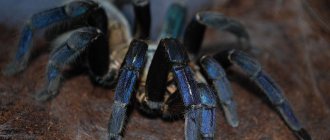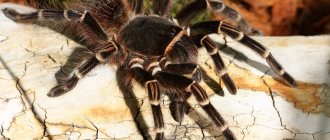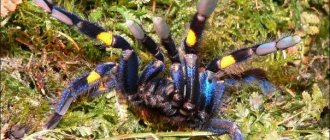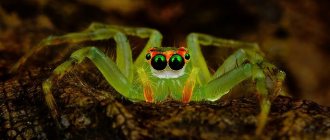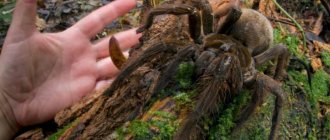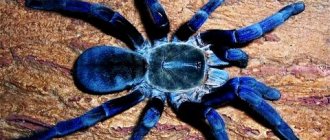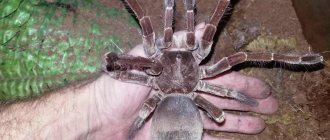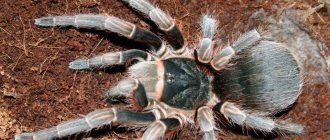Every novice arachnid breeder sooner or later is faced with the question of choosing a convenient terrarium for their pet. Keeping a representative of an exotic species is not as easy as it might seem at first glance. Especially when it comes to tarantulas.
Most arachnophiles acquire low-maintenance spiders. So what should be a suitable terrarium for a tarantula spider to make it comfortable?
Terrarium for a tarantula spider
Tarantulas should be kept in small (up to 30x30x30 cm) terrariums, in which there is free access to air (from above and, very preferably, from the side). The terrarium must be securely closed so that animals and children cannot get there. Do not place the container with the spider in direct sunlight, or near audio speakers or other sources of strong vibration. It should be remembered that nicotine is a strong insecticide and it is advisable that the smoke does not get into the container with the spider. In the summer, it is better not to use mosquito repellent aerosols or fumigators in a room with a spider.
Very often, beginners want to equip a tarantula with a huge terrarium, but this is unnecessary. Tarantula spiders in nature live in burrows, under snags, stones and in any other small and secluded places. Therefore, unlike cats and dogs, they require very little space to live. Remember that the smaller the container, the easier it is to monitor the spider and, most importantly, feed it! The optimal size of the terrarium is two to three times larger than the spider's leg span in an extended position. For terrestrial tarantula spiders, the height of the terrarium plays a vital role, so it should not exceed 25-30 cm. Otherwise, falling even from 50 cm, a large spider can rupture its abdomen, which will lead to a slow and painful death.
Tarantulas can be kept both in inexpensive plastic terrariums and in professional glass ones, with flow ventilation and doors for easy access to the spider. In any case, it is very important that there is good ventilation. This will reduce the likelihood of mold, mildew, mites and other hazards in a humid environment.
Tarantula spiders do not need plants or any decorations, but they can be used to decorate a terrarium. Remember, living plants with “natural” soil may contain parasites, which will have a detrimental effect on the spider, so it is better to give preference to artificial ones. There are so many great imitations of real plants now available that can look even better than their living counterparts.
The vital necessities for tarantulas are a terrarium, coconut substrate, drinking bowl, shelter and heating (provided that your temperature is below 23°C). Everything else is decoration and pleasant little things that will make caring for the spider easier, but will not affect the life and health of the spider.
Breaking news Spiderman drinks water
It’s not often that you see a spider drinking water. But unique footage from a Vladivostok spider holder came into our room.
-So, are you saying that spiders drink water? - Yes. End I have proof - Okay. Show me
- Excuse me, but it seems to me that this cup is empty - It’s empty in your head! The drinking bowl is full to the brim with the wonderful Cranaqua, so the boundaries of the water are not visible
Here's a different perspective for you. Are you satisfied? -Umm..
—Do you have more believable photographs? -What do you say to this?
“I didn’t understand what it was at all. At first I thought that on the left it was the head of an ant with horns, but then it dawned on me that it was an asshole with legs. Yes, then I see that the spider is drinking, oh my gods. It’s just amazing
Pew spiders - Pulchra and Fimbriatus
Possible duplicates found
I didn't understand anything at all.
On Friday, at the end of the day, the spider caught a mosquito with a high alcohol content in the blood it drank, so the spider suffered. I would pour a shot glass for a hangover
They also drink when you might not even notice one spider, but if you want to see for sure, then get 4 of them and then you’ll see for sure.
very beautiful, but you can still crap yourself
And your home ceiling spiders can come down to drink saliva at night while you sleep.
The ceiling flowers saw that tarantulas had come into the house, collected the mantles and eaten them.
drinking water means drinking
Humidity and drinking bowl for tarantula spider
Moisture is the most important criterion when keeping tarantulas. To maintain the required level of humidity, it is necessary to periodically spray the soil with settled water or water from a filter. It is necessary to place a drinking bowl on the ground, which should always contain fresh water. You can use a special decorative drinking bowl for small animals, which is made so that the animal can freely get out of it and not drown. As a compromise, you can use a plastic jar lid or any other shallow container. It is advisable to install it under the wall of the terrarium. At night, in search of food, spiders stumble upon a drinking bowl and replenish their water supplies. To measure humidity, you can use a special hygrometer for terrariums, which can be positioned so that it is hardly noticeable and at the same time performs its direct function. Remember, you can’t make a swamp in the terrarium! Excessive amounts of water can cause mold and mildew to develop, which can kill the tarantula.
Creating favorable conditions
We have a spider, a well-equipped terrarium, how can we now create conditions in which the spider will feel comfortable? First, you need to create the desired temperature. For this, there are various thermal mats, heating stones, thermal cords and other elements, which usually have the ability to set the desired temperature. Absolutely all tarantulas will feel good at a temperature of 25 degrees. Lamps should not be used as a heating device, as light negatively affects the health of the pet. Now let's figure out how to create and maintain the required humidity. Spiders live both in tropical forests, where humidity can sometimes reach 100%, and in deserts, where humidity is minimal and increasing it can kill spiders. Depending on the level of humidity you need, you can divide the procedures for maintaining it into 4 levels:
- 1. 50-60%. At this moisture level, the soil should be completely dry. Spiders, at this level of humidity, should be moistened approximately once every 4-5 days with a spray bottle, or a drinking bowl should be installed, and the spider should be provided with clean water.
- 2. 60-70%. This level is very similar to the previous one. At this level, the spider needs to install a drinking bowl and lightly moisten the soil next to the drinking bowl.
- 3. 70-80%. At this level, it is already necessary to moisten the soil well, but at the same time create dry islands.
- 4. 80-90%. The soil must be kept completely well moistened at all times. You can install artificial waterfalls, but make sure that the spider does not drown in the water. The higher the humidity level, the more the soil should resemble a swamp.
To all of the above, we can add that for measuring humidity there are hygrometers that can be purchased at pet stores. These devices will allow you to create the most suitable humidity level.
Temperature and heating for the tarantula spider
For full development, the spider requires an average room temperature of 23-28°C. If the room is colder, then you can use thermoplates for terrariums. They come in all sizes, attach to any surface and are suitable for all types of terrariums. They also need to be used for some species of tarantulas that require elevated temperatures of 28-30 °C and above. To measure the temperature inside the terrarium you will need a thermometer. Remember that a sharp drop in temperature of even 5 degrees can be fatal for some species of tarantulas!
How to care for pterinopelma sazimai?
For tarantulas, the Sazimay buy a low terrarium with a wide bottom. It must have holes for ventilation. Walking animals is not recommended. They run fast. It will be difficult to catch them in the room. The thickness of the soil for males is 5 cm, for females up to 15 cm.
This difference is due to the fact that females dig holes. The litter is made of peat, sand, and loam. It is constantly irrigated with water, but waterlogging should not be allowed. Mold is harmful to spiders.
- It is recommended to maintain a thermal regime of 22-24 0C. Experts are based on the average temperature of the natural environment. Individuals can withstand both high and lower temperatures, but when kept at home, it is advised to stick to the “golden mean”.
- Soil and air humidity is very important for tarantulas. To maintain it at the level of 80-85%, 5-6 ml of water is evenly poured onto the soil daily.
- Zophobass is used as feed. Adults are given cockroaches. The young animals have poorly developed chelicerae. They are advised to introduce soft foods. Always focus on the size of the individuals. The size of the worms or insects should be 2/3 of the spider's abdomen. So, as food for young animals, they give 1/3 of a cockroach or cricket, ½ of a beetle larva, and zofobas.
Any remaining food must be removed. Otherwise, they will begin to rot, causing a stench and the spread of pathological microflora. Spiders eat at night. It is better to clean the terrarium in the morning. Always make sure that no fruit flies or humpback flies appear inside the box. Insects lay their larvae on the body of spiders.
Young spiders up to one year of age can change their exoskeleton overnight. The older individuals become, the more complex and longer this process takes place.
During this period, it is important for animals to maintain high humidity in the terrarium. When shedding their shell, arthropods release a lot of liquid
Sazimai spiders are not aggressive. In case of danger, they try to hide in their shelter. The poison is defined as low toxic. Individuals often use a “dry bite”. Chelicerae are 2 cm long. The spider bite is very painful and takes a long time to heal. The affected area becomes very inflamed and swollen
Tarantulas are handled with great care
YouTube responded with an error: The request cannot be completed because you have exceeded your quota.
Lighting for tarantula spider
Tarantula spiders are nocturnal animals, so there is no need to worry that your pet is not getting enough light. Quite the contrary, the less light, the better! The terrarium should be in a dark place. For full visibility inside the terrarium, you can use moonlight lamps. They will create an imitation of the night tropics. At the same time, you will be able to observe the spider without creating a stressful situation for it. You cannot place the terrarium in direct sunlight, because... a spider can easily “fry” in the summer sun! Do not use ordinary incandescent lamps to illuminate the terrarium - they dry out and heat the air, and most terrarium accessories can easily melt and even catch fire from high temperatures.
A little dream has come true!
I always wanted to try macro photography on such cute spiders)
Today such an opportunity arose at the Olympus stand during the “Festival of Photography and Technology” in St. Petersburg.
The result is in front of you)
Thank you for your attention!
Food and feeding of the tarantula spider
Tarantula spiders are predators. Their food is any creature suitable in size. Adults can even feed on frogs, mice and lizards (but this is not necessary). The size of the food object should not exceed half the spider’s body, otherwise the spider will be afraid, which will lead to constant stress and further refusal of food. The main food of spiders is insects. There is now a large range of specially grown food insects for terrarium animals that are suitable for all stages of spider development. Do not feed the tarantula with caught insects or animals from nature, because they may carry diseases and/or be treated with chemicals! Remember not to throw many insects at a spider at once! It is necessary to remove the remains of food items in the terrarium within 24 hours, otherwise this can lead to mold and the proliferation of parasites! Do not give your tarantula food the week before and the week after it moults.
Tarantulas should be fed as much as they want. The more often a spider eats, the faster it grows, of course, if it has an appetite. If the spider does not refuse food, then you can give food at least every day, but if you throw an insect and the spider runs away from it (and it is small), try cutting it in half. If this does not force the spider to eat during the day, it means that it is not hungry and, perhaps, is preparing to molt.
Features of choosing a pet
In order to choose a healthy spider, you need to use a few simple tricks that will help protect yourself from wasting money:
- the arthropod must be active and playful. In the case when the specimen you have chosen lies alone on the sidelines, is passive and constantly hides in the house, the animal is most likely sick, and you should not buy such a pet for home;
- A healthy spider's abdomen should be even and smooth. If the abdomen is wrinkled or there are other pathologies on it, the spider suffers from dehydration and may soon die;
- open wounds or ulcerative defects on the body of a tarantula are another reason to refuse to purchase such a spider;
- It is best to purchase small spiderlings , since it is almost impossible to determine the age of a tarantula by appearance;
- It is important to pay attention to the hairs that cover the abdomen. If they are not evenly distributed throughout the body or vary in size, the animal has health problems;
- the absence of paws in most cases is not a pathology , since they will instantly grow back after the next molt. This only means that the animal was not transported properly.
Important! When choosing a tarantula, you need to pay attention especially to females, since males do not have longevity and live several times less.
Handling a tarantula
Remember, the tarantula spider is not a guinea pig or a cat, it is not a contact animal and it is extremely undesirable to handle even “innocent” species! First of all, for the safety of the spider itself! Tarantulas can unexpectedly run very quickly and fall from your hand onto the floor, and falling even from 50 cm onto a hard surface can lead to a rupture of the abdomen and death of the spider. Even the quietest and most peaceful spider can bite, so this is the second point why they should not be picked up. If we haven’t convinced you and you really want to “snuggle” your pet, then here are a few recommendations that will protect you and the tarantula:
- do not make sudden movements, do everything smoothly and slowly;
- do not blow on the spider, because he can run sharply and fall from his hand;
- keep quiet;
- avoid sharp flashes of light;
- do not press it;
- do not do anything that could cause a stressful situation for the spider;
- In any case, you need to be extremely careful.
The safest and most proven way to pick up a spider is to gradually push the spider onto your hand lying on a flat surface so that the spider itself climbs onto your palm. To return the spider, you need to do the same operation only in reverse order.
How to make ventilation in a terrarium from a plastic container:
The first step, and especially in our case, will be to make ventilation holes in the container; it is worth noting that ventilation is very important for all terrarium inhabitants. In my case, I am making an insectarium for Madagascar cockroaches, so I will make ventilation on the side and on the lid so that the air circulates better. In order to cut holes for ventilation, I use a knife heated on a gas stove; it miraculously cuts plastic without breaking it. I would like to point out that this cutting method produces unpleasant smoke, so it is best to open the window in advance. I make two holes: on the side and on the top lid of the future insectarium for cockroaches.
In order to prevent the cockroaches from scattering, these holes need to be sealed with some kind of mesh; for this I use a primitive mosquito net with a fairly small mesh.
I cut out suitable pieces of mesh and glue them with shoe glue. I didn’t have any other glue at hand, it doesn’t look very good, but I’m not chasing it.
In this small and primitive article, I told you how to make a terrarium with your own hands, one that will differ in price from terrariums sold in pet stores. You can ask all questions below or in our VKontakte group. © 2014-2018 website Author:
How does mating happen?
The cage of fattened individuals is always carried out on the territory of the female. Experts recommend preparing the terrarium immediately. The drinking bowl and all decorations are removed from it, leaving only an object that serves as a refuge for the spider.
The soil is moistened. Bring the percentage of air humidity to 60%. The terrarium must have good ventilation.
The spider is placed in a terrarium with a female. He begins to explore the territory. It takes him some time to do this. You should not push him with tweezers or direct him towards the female. At this time, the spider may be in its shelter or sitting on the litter; she waits for manifestations of activity from the male. When spiders are ready to mate, they call for a female by tapping their pedipalps on the ground.
The male slowly approaches the spider. If she is ready for fertilization, then there will be no aggression from her. She raises her upper limbs into a vertical stance. At the same time, a gap opens in her epigastric groove in which the ovaries are located. In female tarantulas this is a paired organ.
The spider holds the female in an upright position with its tibial hooks. It touches the slit in the furrow with its pedipalps, releasing seminal fluid from the bulbs. After mating is completed, the tarantula lowers the female and quickly runs away so as not to experience her aggression.
The process of female fertilization does not end there. Another male is placed next to the spider. Sometimes mating of tarantula spiders continues until the female becomes overly emotional.
Spiders reproduce in natural conditions once a year. When keeping at home, you must follow these rules.
Family name
origin of name
One of the ancient engravings, the image on which served as the basis for the name - tarantula
The name “tarantula spiders” arose as a result of several engravings drawn by the German researcher and animal painter Maria Sibylla Merian and published based on the results of her stay in Suriname (1699-1701) in the work “Metamorphosis insectorum Surinamensium” (1705), where she observed like a large tarantula ( Avicularia sp.
) attacked the hummingbird in the nest.
Problems with the translation of the term
In a number of European languages, tarantulas, and sometimes all large spiders, are often called tarantula. In Russian, the word tarantula is used to designate spiders of a slightly different group, in particular including spiders, which are widespread in the south of Russia. In this regard, confusion often arises when texts are translated incorrectly. In modern biological systematics, the taxa “tarantulas” and “tarantulas” do not overlap; Tarantulas are mygalomorphic spiders, and tarantulas are araneomorphic.
The appearance of offspring
If fertilization is effective, then after 2 months the female lays eggs. Shortly before the predicted laying, it is recommended to replace the soil or clean the terrarium. All remaining feed is removed, preventing the process of rotting. The drinking bowl is cleaned and filled with clean water.
Formation of a cocoon by a female tarantula spider
When breeding tarantula spiders at home, it is necessary to follow the rules of hygiene for arthropods. Individuals are fed protein food: darkling beetle larvae, Madagascar cockroaches.
- If the female begins to abundantly weave the terrarium with cobwebs. This means that she is preparing to lay. It lines the bed, which consists of dense fabric.
- The spider lies down on him and releases eggs from her abdomen. They come out along with a viscous liquid. At this time, the female’s abdomen sharply decreases.
- After laying, the individual begins to collect the entire web into a cocoon. It looks like a small ball.
- The spider constantly moves the cocoon to certain places in the terrarium, looking for the optimal microclimate.
- The air temperature in the container is kept at 24 0C, the humidity is increased to 70%, but you should always be based on the characteristics of the subspecies. Some spiders require higher air temperatures and maximum humidity.
- The incubation period lasts 1-2 months, but already at 35 days nymphs appear in the cocoon. The female helps them break the cocoon.
After the spider has formed a cocoon, it is recommended to inspect it for integrity. Young females do not completely cover the clutch with cobwebs. The eggs may die.
To prevent this from happening, it is recommended to take the cocoon from the female by tossing her a dummy. The holes in the cocoon are sewn up with silk thread and returned to the female. If she does not accept it, then incubation is performed artificially.
Nymphs emerge from the cocoon. They are placed in a separate container, provided with high humidity, and maintained at a temperature of 26-28 0C. You don't need to feed them. They feed on egg yolk. After a month they develop into larvae. I distribute the young animals into separate containers and begin feeding.
The larvae are kept at a temperature of 22-26 0C. Air humidity 70%. You need to be prepared for the fact that tarantulas are fertile. The required number of terrariums and food insects should be prepared.
YouTube responded with an error: The request cannot be completed because you have exceeded your quota.
Interesting Facts
The tarantula spider is a popular animal that attracts people with its large size and original appearance. There is a lot of interesting information about these amazing creatures:
- Spiders do not experience a sense of affection, so when kept at home, you should not think that the animal is attached to its owner and loves him.
- It is impossible to train a tarantula and also be completely sure of the absence of aggression on its part.
- Even the most calm and balanced individuals bite their own owners from time to time.
- Females are larger in size than males.
- Many females devour males after mating.
- Females live longer, up to 30 years, so they are more expensive.
- Females lay approximately 2,000 eggs, which are placed in a cocoon of spider webs and hatch after 1 to 3 months.
- The terrarium with the spider should always be closed with a tight lid. If there are children at home, it is necessary to use a lock, this will protect the child from an accident.
- Spiders are representatives of a separate class, so it is not entirely correct to classify them as insects.
- Tarantulas are the largest spiders in the world.
- Animals use an original method of protection from enemies - blinding by a stream of feces.
- Arthropods are capable of not eating food for more than 2 years.
- Some species are excellent swimmers and divers;
- To treat the fear of spiders (arachnophobia), experts recommend that patients keep tarantulas in their homes to overcome the disease on their own. According to statistics, the technique brings positive results.
Before purchasing a bird catcher, you need to think about the burden of responsibility that will lie on the owner of such a pet. The animal is a long-livers and needs care and proper care.
Tarantula spider
